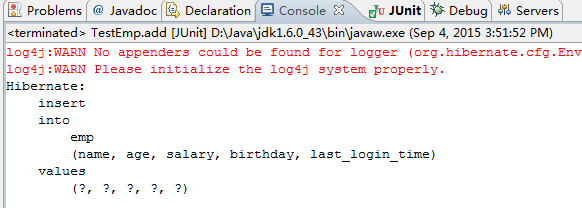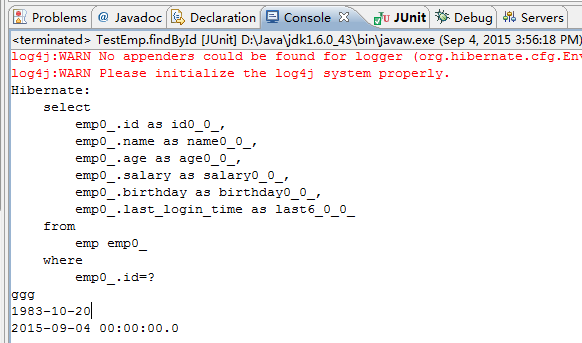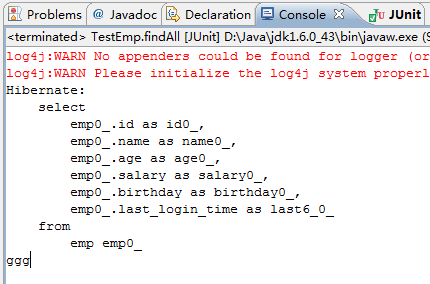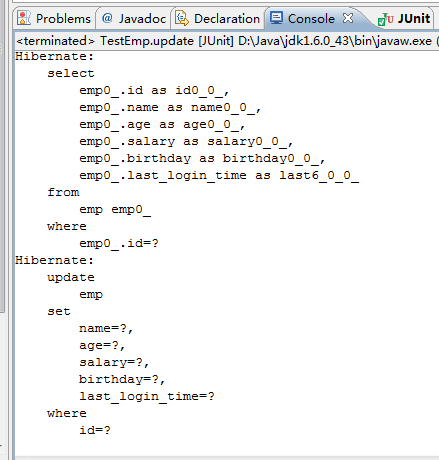1.1 问题
使用Hibernate实现对员工表的增、删、改、查。
1.2 方案
Hibernate使用步骤:
- 导入Hibernate包,以及数据库驱动包。
- 引入Hibernate主配置文件hibernate.cfg.xml。
- 创建实体类。
- 创建映射关系文件。
- 使用Hibernate常用API执行增删改查操作。
1.3 步骤
实现此案例需要按照如下步骤进行。
环境为:myeclipse 6.5 ,mysql 5.0 ,Hibernate 3 。
步骤一:准备工作创建员工表EMP,建表语句如下:
CREATE TABLE `emp` ( `ID` INT(4) NOT NULL AUTO_INCREMENT, `NAME` VARCHAR(50) NOT NULL, `AGE` INT(11) DEFAULT NULL, `SALARY` DOUBLE(7,2) DEFAULT NULL, `MARRY` CHAR(1) DEFAULT NULL, `BIRTHDAY` DATE DEFAULT NULL, `LAST_LOGIN_TIME` DATE DEFAULT NULL, PRIMARY KEY (`ID`) ) ENGINE=INNODB DEFAULT CHARSET=utf8
创建一个WEB项目,名为Hibernate。
步骤二:导入Hibernate开发包,以及数据库驱动包,完成后项目的包结构如下图:

网盘下载jar包: http://yunpan.cn/cmRG5gzdMtGMX 访问密码 3747
步骤三:引入Hibernate主配置文件
将Hibernate主配置文件hibernate.cfg.xml复制到项目中,放在src根路径下。并在主配置文件中配置好数据库连接信息,以及Hibernate框架参数,代码如下:
<?xml version="1.0" encoding="UTF-8"?> <!DOCTYPE hibernate-configuration PUBLIC "-//Hibernate/Hibernate Configuration DTD 3.0//EN" "http://hibernate.sourceforge.net/hibernate-configuration-3.0.dtd"> <hibernate-configuration> <session-factory> <!-- 数据库连接信息,根据自己的数据库进行配置--> <property name="connection.url">jdbc:mysql://localhost:3306/souvc</property> <property name="connection.username">root</property> <property name="connection.password">123456</property> <property name="connection.driver_class">com.mysql.jdbc.Driver</property> <!-- Hibernate配置信息 --> <!-- dialect方言,用于配置生成针对哪个数据库的SQL语句 --> <property name="dialect"> <!-- 方言类,Hibernate提供的,用于封装某种特定数据库的方言 --> <!-- org.hibernate.dialect.OracleDialect --> org.hibernate.dialect.MySQLDialect </property> <!-- Hibernate生成的SQL是否输出到控制台 --> <property name="show_sql">true</property> <!-- 将SQL输出时是否格式化 --> <property name="format_sql">true</property> </session-factory> </hibernate-configuration>
步骤四:创建实体类
创建包com.souvc.entity,并在该包下创建员工表对应的实体类Emp.java,用于封装员工表的数据,代码如下:
package comsouvc.entity; import java.sql.Date; import java.sql.Timestamp; public class Emp { private Integer id; private String name; private Integer age; private Double salary; private Boolean marry; private Date birthday; private Timestamp lastLoginTime; public Integer getId() { return id; } public void setId(Integer id) { this.id = id; } public String getName() { return name; } public void setName(String name) { this.name = name; } public Integer getAge() { return age; } public void setAge(Integer age) { this.age = age; } public Double getSalary() { return salary; } public void setSalary(Double salary) { this.salary = salary; } public Boolean getMarry() { return marry; } public void setMarry(Boolean marry) { this.marry = marry; } public Date getBirthday() { return birthday; } public void setBirthday(Date birthday) { this.birthday = birthday; } public Timestamp getLastLoginTime() { return lastLoginTime; } public void setLastLoginTime(Timestamp lastLoginTime) { this.lastLoginTime = lastLoginTime; } }
步骤五:创建映射关系文件
在com.souvc.entity包下,创建员工实体类的映射关系文件,名为Emp.hbm.xml,并在该文件中配置实体类和表的关系,以及类中属性和表中字段的关系,代码如下:
<?xml version="1.0" encoding="utf-8"?> <!DOCTYPE hibernate-mapping PUBLIC "-//Hibernate/Hibernate Mapping DTD 3.0//EN" "http://hibernate.sourceforge.net/hibernate-mapping-3.0.dtd"> <hibernate-mapping> <!-- 配置实体类和表的关系 --> <class name="com.souvc.entity.Emp" table="emp"> <!-- 配置主键属性和字段的关系 --> <id name="id" type="java.lang.Integer" column="id"> <!-- 用来指明主键的生成方式 --> <!-- <generator class="sequence"> <param name="sequence">emp_seq</param> </generator> --> <generator class="native"> </generator> </id> <!-- 配置实体类中属性与表中字段的关系 --> <property name="name" type="java.lang.String" column="name" /> <property name="age" type="java.lang.Integer" column="age" /> <property name="salary" type="java.lang.Double" column="salary" /> <property name="birthday" type="java.sql.Date" column="birthday" /> <property name="lastLoginTime" type="java.sql.Timestamp" column="last_login_time" /> </class> </hibernate-mapping>
步骤六:声明映射关系文件
在主配置文件hibernate.cfg.xml中,声明映射关系文件Emp.hbm.xml,代码如下:
<!-- 声明映射关系文件 -->
<mapping resource="com/souvc/entity/Emp.hbm.xml" />
完成代码如下:
<?xml version="1.0" encoding="UTF-8"?> <!DOCTYPE hibernate-configuration PUBLIC "-//Hibernate/Hibernate Configuration DTD 3.0//EN" "http://hibernate.sourceforge.net/hibernate-configuration-3.0.dtd"> <hibernate-configuration> <session-factory> <!-- 数据库连接信息,根据自己的数据库进行配置 <property name="connection.url"> jdbc:oracle:thin:@localhost:1521:xe </property> <property name="connection.username">lhh</property> <property name="connection.password">123456</property> <property name="connection.driver_class"> oracle.jdbc.OracleDriver </property> --> <property name="connection.url">jdbc:mysql://localhost:3306/souvc</property> <property name="connection.username">root</property> <property name="connection.password">123456</property> <property name="connection.driver_class">com.mysql.jdbc.Driver</property> <!-- Hibernate配置信息 --> <!-- dialect方言,用于配置生成针对哪个数据库的SQL语句 --> <property name="dialect"> <!-- 方言类,Hibernate提供的,用于封装某种特定数据库的方言 --> <!-- org.hibernate.dialect.OracleDialect --> org.hibernate.dialect.MySQLDialect </property> <!-- Hibernate生成的SQL是否输出到控制台 --> <property name="show_sql">true</property> <!-- 将SQL输出时是否格式化 --> <property name="format_sql">true</property> <!-- 声明映射关系文件 --> <mapping resource="com/souvc/entity/Emp.hbm.xml" /> </session-factory> </hibernate-configuration>
步骤七:创建Session工具类
创建HibernateUtil工具类,用于创建Session对象,代码如下:
package com.souvc.util; import org.hibernate.Session; import org.hibernate.SessionFactory; import org.hibernate.cfg.Configuration; public class HibernateUtil { private static SessionFactory sessionFactory; static { // 加载Hibernate主配置文件 Configuration conf = new Configuration(); conf.configure("/hibernate.cfg.xml"); sessionFactory = conf.buildSessionFactory(); } /** * 创建session */ public static Session getSession() { return sessionFactory.openSession(); } public static void main(String[] args) { System.out.println(getSession()); } }
输出效果:
SessionImpl(PersistenceContext[entityKeys=[],collectionKeys=[]];ActionQueue[insertions=[] updates=[] deletions=[] collectionCreations=[] collectionRemovals=[] collectionUpdates=[]])
步骤八:练习使用Hibernate对员工表进行增删改查
创建包com.souvc.test,并在该包下创建一个JUNIT测试类,并在类中使用Hibernate写出对EMP表的增删改查的方法,代码如下:
package com.souvc.test; import java.sql.Date; import java.sql.Timestamp; import java.util.List; import org.hibernate.HibernateException; import org.hibernate.Query; import org.hibernate.Session; import org.hibernate.Transaction; import org.junit.Test; import com.souvc.util.HibernateUtil; import comsouvc.entity.Emp; /** * 演示Hibernate的基本使用 */ public class TestEmp { /** * 新增emp */ @Test public void add() { // 模拟要新增的emp Emp e = new Emp(); e.setName("ggg"); e.setAge(29); e.setMarry(false); e.setSalary(8000.00); e.setBirthday(Date.valueOf("1983-10-20")); e.setLastLoginTime(new Timestamp(System.currentTimeMillis())); // 获取session Session session = HibernateUtil.getSession(); // 开启事务 Transaction ts = session.beginTransaction(); try { // 执行新增 session.save(e); // 提交事务 ts.commit(); } catch (HibernateException e1) { e1.printStackTrace(); // 回滚事务 ts.rollback(); } finally { session.close(); } } /** * 根据ID查询emp */ @Test public void findById() { Session session = HibernateUtil.getSession(); Emp emp = (Emp) session.get(Emp.class, 1); System.out.println(emp.getName()); System.out.println(emp.getBirthday()); System.out.println(emp.getLastLoginTime()); session.close(); } /** * 修改emp */ @Test public void update() { Session session = HibernateUtil.getSession(); // 查询要修改的数据 Emp emp = (Emp) session.get(Emp.class, 1); // 开启事务 Transaction ts = session.beginTransaction(); try { // 模拟修改数据 emp.setName("ee"); emp.setAge(20); // 执行修改 session.update(emp); // 提交事务 ts.commit(); } catch (HibernateException e) { e.printStackTrace(); // 回滚事务 ts.rollback(); } finally { // 关闭连接 session.close(); } } /** * 删除emp */ @Test public void delete() { Session session = HibernateUtil.getSession(); Emp emp = (Emp) session.get(Emp.class, 1); Transaction ts = session.beginTransaction(); try { session.delete(emp); ts.commit(); } catch (HibernateException e) { e.printStackTrace(); ts.rollback(); } finally { session.close(); } } /** * 查询全部emp */ @Test public void findAll() { String hql = "from Emp"; Session session = HibernateUtil.getSession(); Query query = session.createQuery(hql); List<Emp> emps = query.list(); for (Emp e : emps) { System.out.println(e.getName()); } session.close(); } }
九、实例的效果图如下:
增加:

通过id查询:

查询全部:

更新:


删除:

温馨提示:注意数据库要存在id为1 的数据,才能进行这些数据的操作。根据自己里面的数据来定id。
源码如下: http://yunpan.cn/cmR97XCh6SvB6 访问密码 afb4